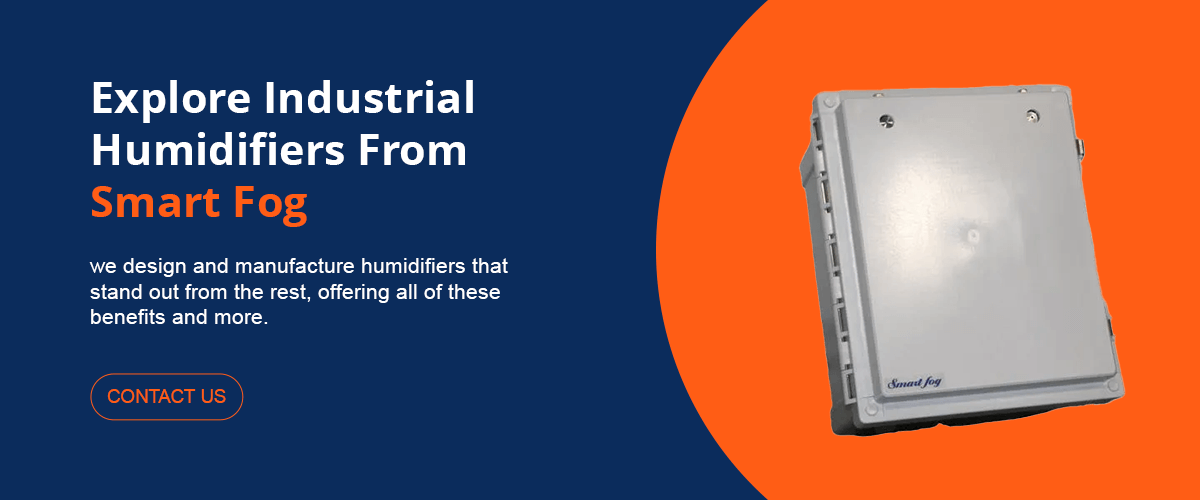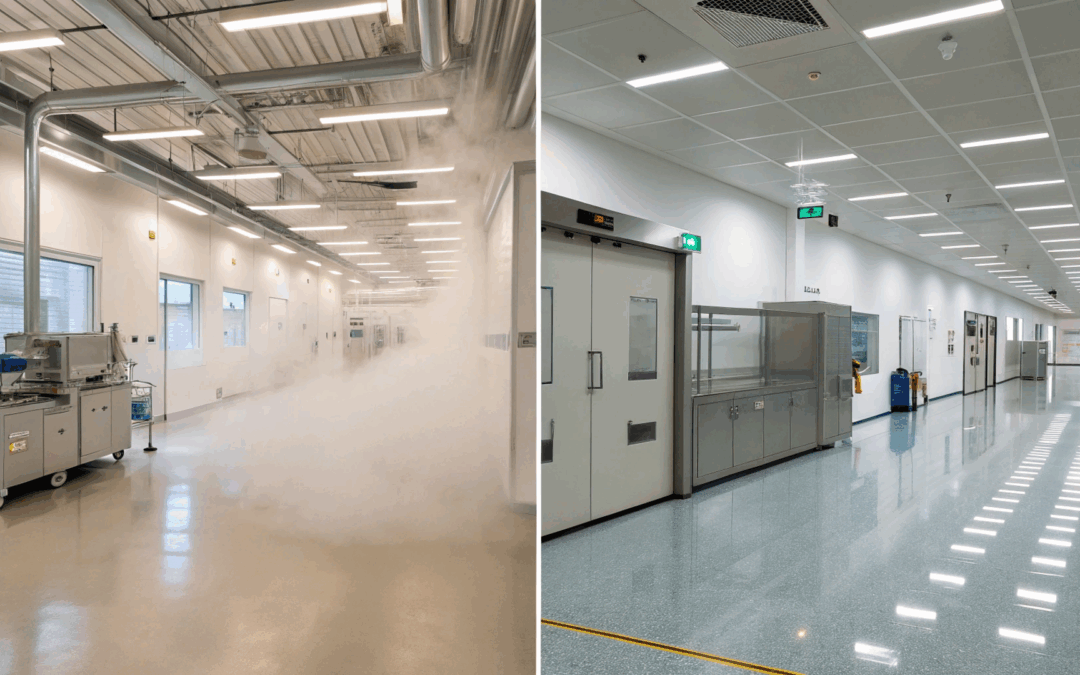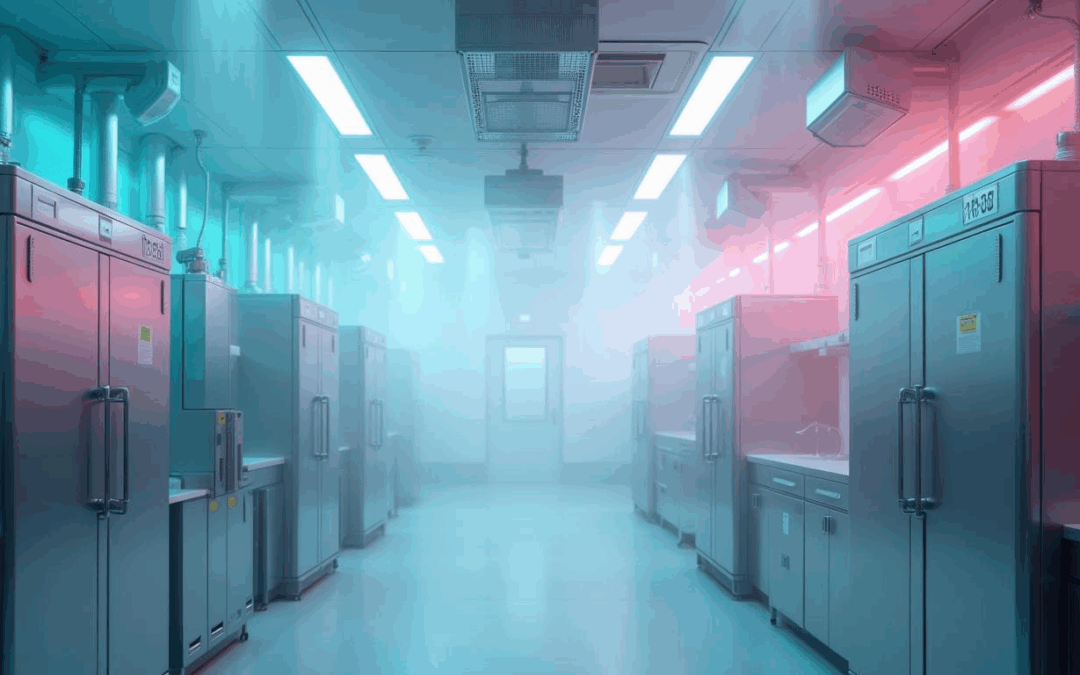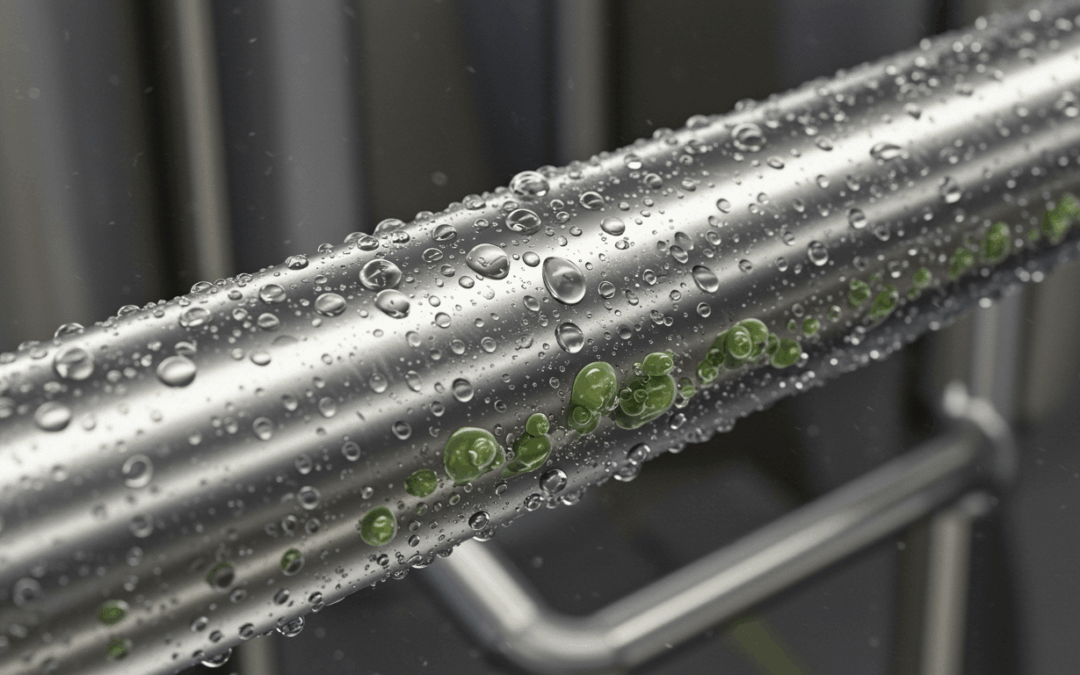Maintaining sufficient humidity levels in industrial and commercial settings is crucial because slight fluctuations in these environments can have a negative impact on your processes and product quality. Relying on traditional humidification systems often leads to challenges like inefficiency, energy wastage and microbial growth.
These challenges undermine the efforts of facility managers when it comes to maintaining optimal humidity. This industrial humidifier buying guide highlights the advanced solutions that Smart Fog humidification systems offer and how they are designed to address these challenges. We’ll also provide a broader view of humidification systems to help you select the best industrial humidifiers for your large-scale commercial needs.
How Do Industrial Humidifiers Benefit Your Business?
Undoubtedly, optimal humidity is critical to any facility and the lack of it could lead to many problems. But how do these heavy-duty humidifiers help your business? Here are some of the benefits of industrial humidifiers:
1. Improves Air Quality
Your facility’s overall air quality has a negative effect on people as well as your processes. Humidified air captures and settles airborne particles, creating cleaner air and protecting workers from respiratory diseases. The right amount of moisture in the air also supports your heating and cooling systems and prevents defects caused by dust and static.
2. Enhances Worker Comfort
Dry air causes discomfort and leads to conditions such as itching, dry eyes and chapped lips. The worst-case scenario is the spread of illnesses because bacteria and viruses thrive where there’s a lack of sufficient humidity. Having a reliable commercial humidification unit maintains optimal levels of moisture in the air, which prevents irritation to the skin and respiratory system.
In addition, proper humidity levels control airborne particles like dust and residue from processing activities, which can lead to asthma and other forms of inflammation. Ensuring a proper work environment enhances your employees’ health, comfort and productivity.
3. Preserves Product Quality
Humidity control preserves product quality across various industries like food processing, which heavily relies on optimal conditions to prevent spoilage. The same goes for commercial indoor grow areas, where plants need adequate moisture levels to maintain healthy growth. Outside agriculture and food processing, a good example is printing facilities, where humidity control prevents paper curling and other costly damage.
4. Controls Static Electricity
Insufficient humidity leads to dry air, which promotes the buildup of electrostatic discharge (ESD). Static electricity in the air is a safety hazard as it can easily spark fires and explosions, especially in flammable areas. It can also damage sensitive electronic devices and machinery, resulting in costly downtimes and losses. Humidifiers lower static electricity and maintain an optimal work environment by increasing the moisture level in the air.
5. Protects Materials and Equipment
One of the key benefits of commercial humidifiers is the preservation of materials and the prevention of spoilage. These machines offer climate control, creating ideal conditions for materials that are sensitive to humidity fluctuations. Maintaining proper moisture levels can help prevent deterioration problems such as shrinkage, cracking and warping.
Aside from materials, proper humidity also protects equipment, contributing to reduced maintenance costs and extended lifespan. That’s because inconsistent humidity may trigger corrosion, decay and other damage.
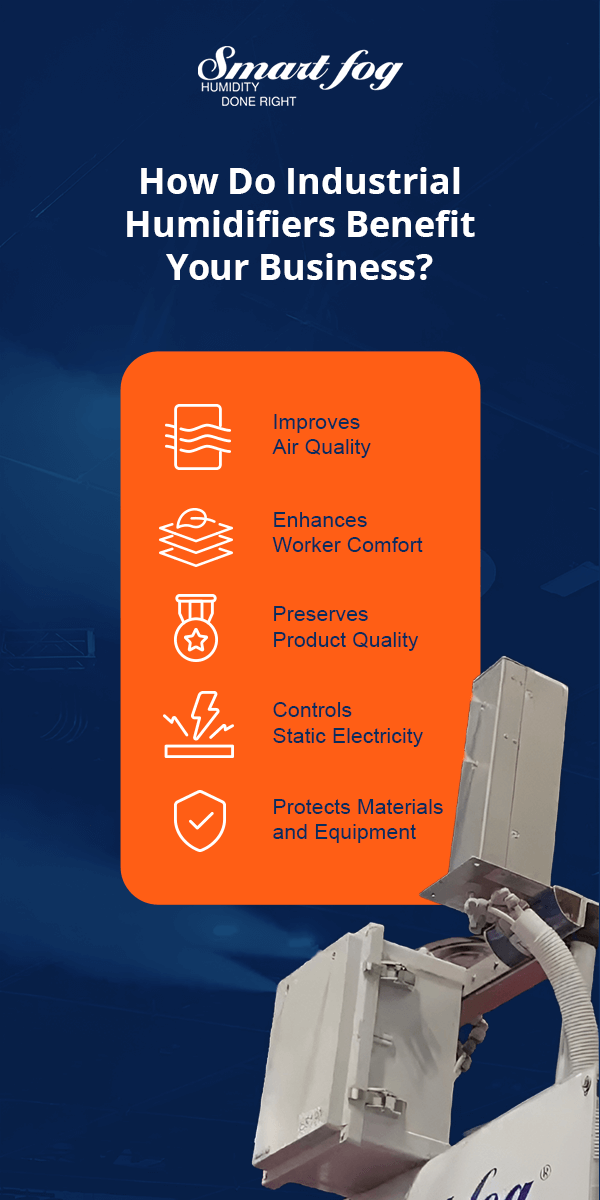
How to Choose a Humidifier for Your Business
Choosing an industrial humidifier can be a weighty decision because it’s a sizable investment with implications on your process and bottom line. You want to make the right decision to avoid costly mishaps. Here are factors to consider when selecting an industrial or commercial humidifier:
- Facility size: The size of your facility or floor space is critical in choosing humidifiers because you want a machine with a capacity that matches your space. Getting a lower capacity will lead to insufficient humidity levels within the coverage area.
- Target humidity level: Depending on your applications, you’ll have varying humidity needs. Your humidity needs may range from precise humidity control required in hospitals to merely sufficient ranges to prevent static and damage to materials. As such, you want to determine your target relative humidity for your needs so you can find the right product.
- Type of humidifier desired: There are two classes of industrial humidifiers distinguished by how they operate — adiabatic and isothermal. Selecting the correct type for your specific needs is key to ensuring efficiency.
- Maintenance requirements: Not all humidifiers are made the same. Like other products, quality can vary from one brand to another. Consider durability and maintenance needs when selecting a unit. That includes the cost of replacement parts, cleaning and servicing frequency and ease of repairs.
- Energy efficiency: Since there are different humidifier technologies, they differ in terms of energy consumption. For example, while steam humidifiers are effective, they consume a lot of energy due to their water-heating operation. Other alternatives, like evaporative and ultrasonic humidifiers, have a low energy consumption as they don’t require heat to operate.
- Noise levels: Noise levels can be a decisive factor based on where your facility is located. Remote facilities may have no issue with noise humidifiers as long as they function well. For urban commercial spaces, you may need quieter models due to restrictions.
Types of Industrial Humidifiers
There are different types of humidifiers on the market, which can make selecting the most appropriate one challenging. Here are the categories of commercial humidifiers you should know about:
Isothermal Humidifiers
Also known as steam humidifiers, these are traditional humidification systems that discharge moisture into the air by generating steam. The working principle for all isothermal humidifiers is to create steam, cool it and disperse it. However, the steam generation process varies, which is why there are different types of steam-based humidifiers, such as:
- Electrode steam humidifiers: These use the electrical conductivity of water to generate steam. Electric current flows through water containing immersed electrodes, causing the water to heat up.
- Resistance steam humidifiers: These are more traditional types that heat water using metal heating elements.
- Gas-fired humidifiers: These are like boilers as they use gas burners to boil water. They can generate large volumes of steam and are ideal for larger applications.
- Steam-to-steam humidifiers: These rely on an existing steam source to generate cleaner steam for humidification.
Adiabatic Humidifiers
Adiabatic humidifiers rely on water atomization or an evaporation process to produce moisture. Unlike isothermal types, these systems do not heat water. Instead, the adiabatic humidification process generates moisture by spraying tiny water droplets into the air. As the droplets absorb heat from the air, they evaporate.
The outcome is both humidification and cooling as the machine uses the heat present in the air to evaporate water droplets. Adiabatic humidifiers are some of the most effective industrial humidifiers with low maintenance costs.
Like steam-based humidifiers, there are different types of adiabatic humidifiers. These are:
- High-pressure humidifier: These systems force water droplets through tiny nozzles at high pressure to create a fine mist.
- Compressed air humidifier: They produce a fine mist by mixing water with compressed air.
- Centrifugal humidifier: They use high-speed rotary plates to break water into a fine mist.
- Ultrasonic humidifier: These rely on high-frequency transducer vibrations to break water into a fine mist.
Smart Fog Humidifiers
Smart Fog humidifiers employ a unique self-evaporative technology, which reverses the molecular attraction of water. The concept known as Tailor Molecular Behavior ensures that the released moisture doesn’t form puddles, condensation and uneven coverage. As a result, there’s uniform humidity.
The system’s exceptional humidity control restricts fluctuations within 1%–2% regardless of outside temperature. Compared to other systems, which have as high as 10% humidity fluctuation, Smart Fog offers a cleaner and no-wetting solution.
In addition, Smart Fog systems are designed to match the unique custom needs of every facility, with a focus on enhancing humidification and cutting costs. As the ideal industrial humidifier with low maintenance, a Smart Fog unit guarantees the right capacity for the space.
Choosing the Right Humidifier Technology: A Deep Dive Into Smart Fog
To reap the benefits of industrial humidification while minimizing downsides begins with choosing the correct humidifier technology. Here are factors to consider when comparing different humidifier technologies:
- Understanding your needs: Begin by identifying your needs. That means determining the size, layout and applications of your facility, since these aspects will inform your specific humidity requirements.
- Accuracy: Precise humidity control is crucial if you’re looking to maintain optimal levels without fluctuations that could be damaging. Unlike other humidifiers, Smart Fog systems excel in this area because they offer accurate humidity control with 1%-2% limited fluctuation.
- Efficiency: While steam-based systems work fine, they are not ideal if you’re looking for an economical solution. Smart Fog’s adiabatic systems are low-voltage and have a double cooling effect, which lowers energy costs. The self-evaporative technology also ensures 100% water efficiency.
- Maintenance: A reliable humidifier should be effective, but not at the expense of maintenance needs. Most isothermal types struggle with efficiency and maintenance challenges. You want a cutting-edge system like Smart Fog that has no moving parts and is low maintenance.
- Hygiene: Droplets from typical humidifiers move around dust and contaminants without effectively getting rid of them. Ultra-fine Smart Fog droplets oxidize contaminants and evaporate before reaching the surface. A quality that makes Smart Fog the most reliable industrial humidifier for improved air quality.
- Long-term cost: Smart Fog systems employ innovative technologies that offer a series of features that lead to long-term cost savings, such as reduced maintenance, the lack of wetting and mold, energy efficiency, low voltage and accurate humidity control.
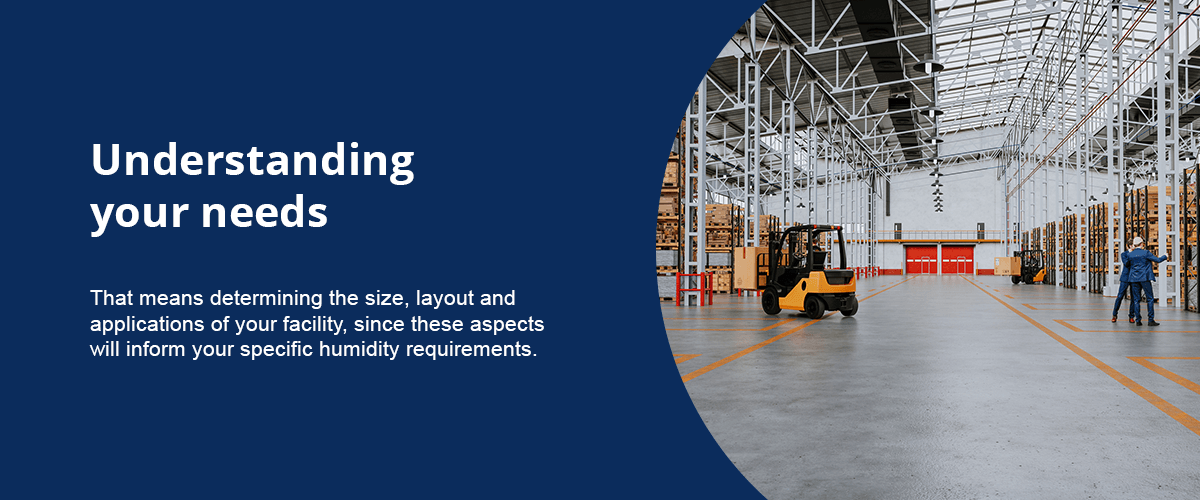
The table below compares Smart Fog to other technologies.
| Feature | Smart Fog | Ultrasonic | Atomization | High Pressure | Steam |
|---|---|---|---|---|---|
| Safe, Low-Pressure | Yes | Yes | Yes | No | No |
| Easy Installation | Yes | Yes | No | No | No |
| Improved Room Hygiene | Yes | No | No | No | No |
| Long-Term Savings | Yes | No | No | No | No |
| 100% Water Efficiency | Yes | No | No | No | No |
| Low Maintenance | Yes | No | No | No | No |
| 100% Dust Suppression | Yes | No | No | No | No |
| No Regulations Required | Yes | No | No | No | No |
| No Moving Parts | Yes | No | No | No | No |
| Uniform Evaporation | Yes | No | No | No | No |
The Science Behind Smart Fog
Smart Fog systems utilize self-evaporative technology, which reverses the natural attraction of water molecules when they disperse into the air as tiny droplets. The Lenard effect employed in this process breaks the bonds of these water molecules, allowing droplets to repel each other and distribute evenly. Due to the even distribution of droplets and complete evaporation before touching the ground, it creates a more uniform humidity without excessive moisture.
In addition, Smart Fog produces ultra-fine 4.2-micron water droplets. The intentional droplet size is designed to capture, oxidize and eliminate pollutants such as dust, viruses, bacteria and other unwanted particles. How water droplets in Smart Fog systems behave also significantly varies from other systems.
For example, Wet Fog droplets rain down, bursting and wetting surfaces. The same goes for Dry Fog droplets, which fall straight down but have rebounding characteristics. Both systems create condensation and wet areas that are a perfect environment for mold and bacterial growth. Smart Fog droplets display uniform coverage and complete evaporation, which prevents these issues.
Applications of Industrial and Commercial Humidification
Proper humidification is necessary in various industries as it creates an optimal environment that supports different processes. Here are some of the industries that rely on humidification systems:
- Agriculture: Agricultural fields ranging from indoor growing and greenhouse to wineries and cannabis cultivation require precise humidity control for optimal plant growth.
- Manufacturing: Reliable humidity levels are required to prevent the buildup of static electricity and reduce pollutants.
- Data centers: Humidity control is key to ensuring strict environmental control in technological facilities like data centers to prevent equipment failure.
- Food processing: Precise humidity levels help to prevent spoilage and maintain product quality.
- Textile: A controlled humid environment maintains material quality, making them less prone to breakage, heating, brittleness and friction.
While other humidification systems can support the needs of various industries, they are not entirely efficient and may fail in terms of accurate humidity control and wetting. Smart Fog systems are tailored to the diverse needs of different industries and applications, ensuring reliability.
Buyers Guide to Industrial Humidifiers
Follow this step-by-step industrial and commercial humidifier buying guide to make an informed decision:
- Assess your needs: Your needs will give you a clear picture when moving forward. Identify your application, which comes with different industries and then narrow down to a specific purpose critical to your operations. That could be precise humidification, static control or just reliable dust suppression and air purification.
- Research different technologies: As we’ve seen, different technologies achieve humidification in different ways. The diverse processes also lead to pros and cons that you’ll need to evaluate before settling on the type you want.
- Consider long-term costs: Factor in energy consumption, maintenance and water usage. Humidifiers that score lower in these areas offer the most cost savings. These are high-value humidifiers proven for durability and longevity.
- Evaluate installation requirements: Can your in-house technicians manage installation, or do you need professional installation conducted by experts familiar with the specific brand? The easier a system is, the better it is when it comes to installation and repairs. Smart Fog units, for example, have no moving parts, which makes them easier to handle.
- Read reviews and testimonials: Once you’ve narrowed down your shortlist, browse reviews and testimonials to see what previous customers have to say about each device.
- Request a consultation: How convenient is it to get in touch with a provider and discuss your needs? When you contact Smart Fog, you get a personalized assessment and recommendation.
Explore Industrial Humidifiers From Smart Fog
Selecting the right industrial humidifier for your business is essential for maintaining sufficient humidity levels, preserving product quality and ensuring a comfortable environment. There are so many options available on the market, but most only provide some of these benefits. At Smart Fog, we design and manufacture humidifiers that stand out from the rest, offering all of these benefits and more.
Our innovative technologies and personalized approach enable us to provide reliable humidification solutions that meet the unique demands of your environment. Contact Smart Fog today to schedule a free consultation with an expert!



